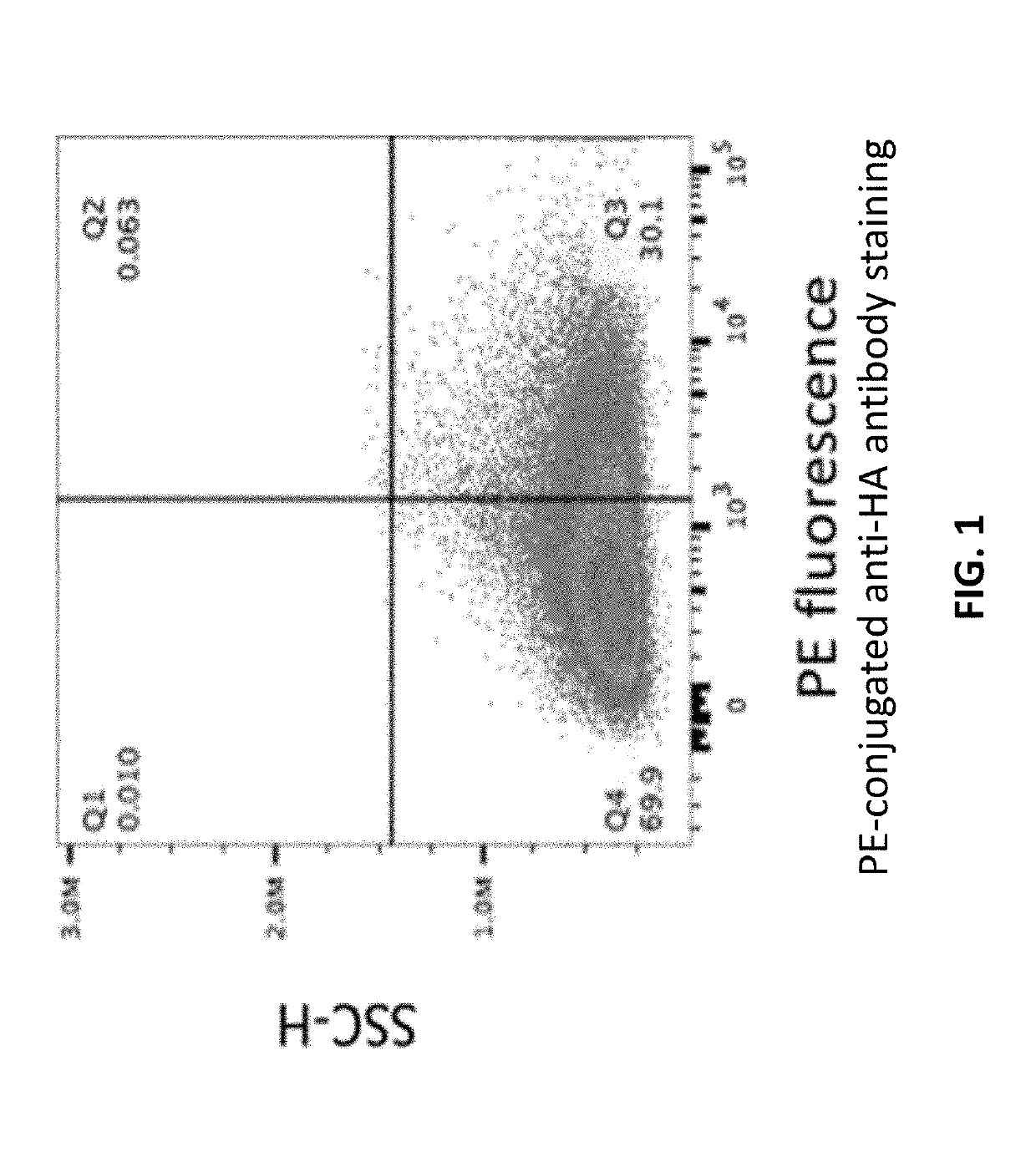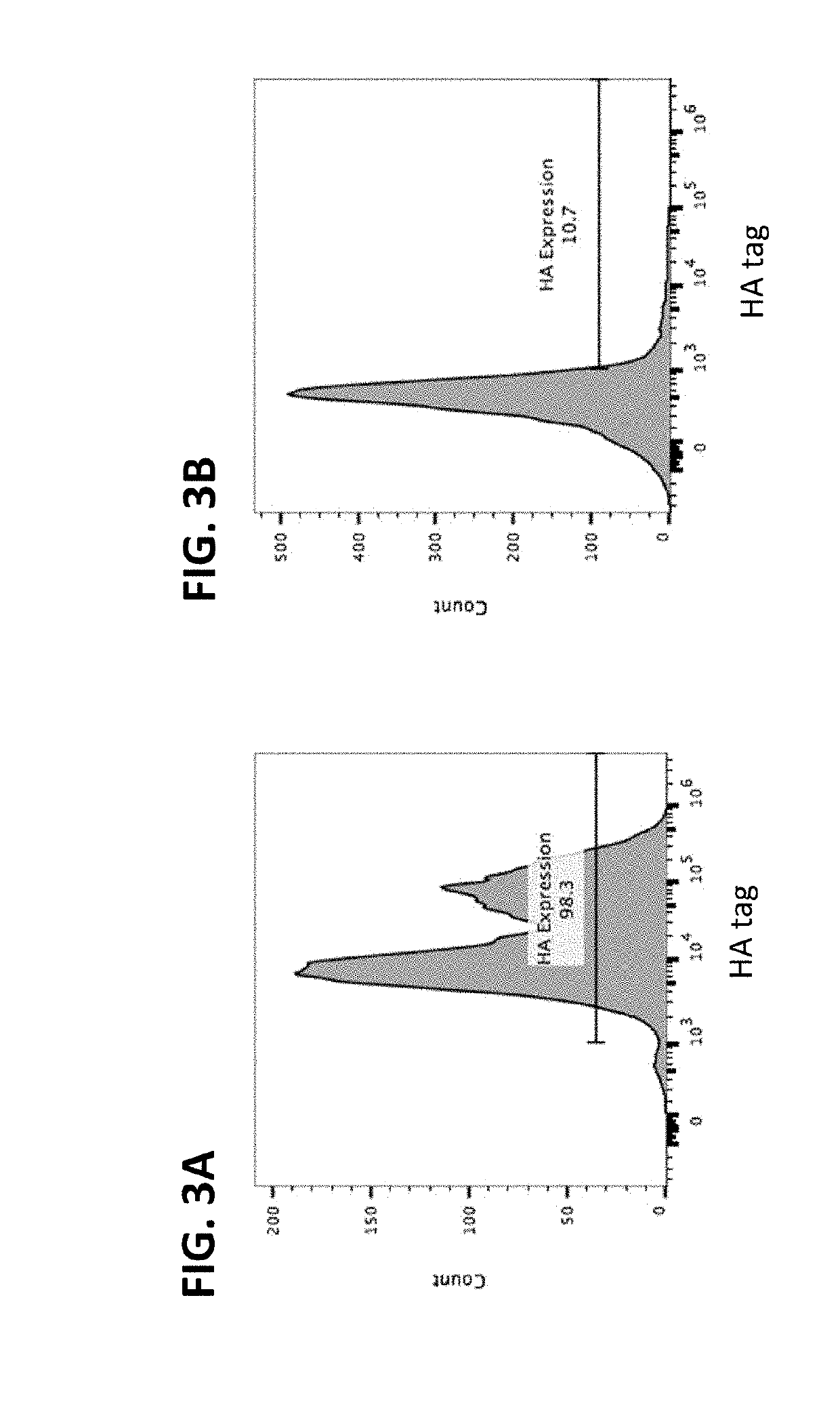Compositions and methods related to therapeutic cell systems for tumor growth inhibition
a technology of tumor growth inhibition and cell system, applied in the direction of his-tag polypeptides, drug compositions, peptides, etc., can solve the problems of undesirable clinical reactions and toxicity in non-cancerous cells
- Summary
- Abstract
- Description
- Claims
- Application Information
AI Technical Summary
Benefits of technology
Problems solved by technology
Method used
Image
Examples
example 1
Cells are Genetically Engineered to Express an Amino Acid Degradative Enzyme
Results
[0254]Erythroid cells were electroporated to express a fusion protein comprising the Kell transmembrane domain fused to an amino acid degradative enzyme, Erwinia asparaginase (Kell-ErwASNase) (SEQ ID NO: 1) on the surface, and having an HA tag, as described in the “Methods” section below. The electroporated cells were incubated with PE-conjugated anti-HA tag antibody and analyzed via flow cytometry. A gate was set based on stained non-electroporated cells. As shown in FIG. 1, over 30% of cells in the population had asparaginase on their surface at a level above this cutoff.
Methods
Expansion and Differentiation of Erythroid Cells
[0255]Human CD34+ cells derived from mobilized peripheral blood cells from normal human donors were purchased frozen from AllCells Inc. The expansion / differentiation procedure comprised 3 stages. In the first stage, thawed CD34+ erythroid precursors were cultured in Iscove's MDM...
example 2
Cells are Genetically Engineered to Express a Cell Targeting Moiety, which Binds its Ligand
[0257]Erythroid cells were transduced to express a fusion protein comprising a GPA transmembrane domain fused to a cell targeting moiety, an anti-CD33 scFv (HA-αCD33scFv-GPA) (SEQ ID NO: 2). Cell culture and transduction was performed as described in “Methods” section below to yield erythroid cells expressing an anti-CD33 antibody molecule on the surface, anchored with a GPA transmembrane domain.
[0258]Because the construct contains an HA tag, the exogenous protein can be detected with a labeled anti-HA antibody. Transduced cells were incubated with recombinant CD33-HisTag to detect binding of the exogenous HA-αCD33scFv-GPA to its ligand. The cells were subsequently co-incubated with an APC-conjugated anti-HisTag antibody to detect the bound CD33-HisTag, and PE-conjugated anti-HA tag antibody to detect the HA tag in the exogenous HA-αCD33scFv-GPA. The cells were analyzed by flow cytometry for A...
example 3
Cells Expressing an Amino Acid Degradative Enzyme can Degrade its Amino Acid Substrate
[0264]Erythroid cells were genetically engineered to express a fusion protein comprising the Kell transmembrane domain fused to an amino acid degradative enzyme, Erwinia asparaginase, as described in Example 1. 1e6 erythroid cells expressing Kell-ErwASNase anchored with a Kell transmembrane domain on the surface were incubated with 100 uM asparagine in 100 uL of PBS. 20 uL aliquots were taken at the indicated time points, cells were eliminated via centrifugation, and the supernatant was analyzed for asparagine concentration via mass spectrometry. FIG. 4 shows that non-electroporated control cells (circles) do not significantly reduce asparagine levels in this assay, whereas cells expressing the asparaginase molecule (squares) reduce asparagine levels by 94.6% over the course of the assay.
PUM
| Property | Measurement | Unit |
|---|---|---|
| Fraction | aaaaa | aaaaa |
| Fraction | aaaaa | aaaaa |
| Fraction | aaaaa | aaaaa |
Abstract
Description
Claims
Application Information
 Login to View More
Login to View More - R&D
- Intellectual Property
- Life Sciences
- Materials
- Tech Scout
- Unparalleled Data Quality
- Higher Quality Content
- 60% Fewer Hallucinations
Browse by: Latest US Patents, China's latest patents, Technical Efficacy Thesaurus, Application Domain, Technology Topic, Popular Technical Reports.
© 2025 PatSnap. All rights reserved.Legal|Privacy policy|Modern Slavery Act Transparency Statement|Sitemap|About US| Contact US: help@patsnap.com



